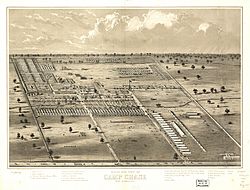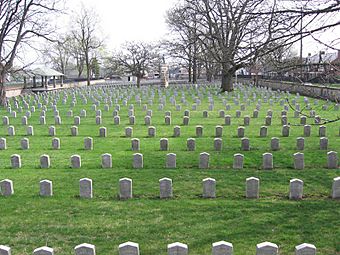Camp Chase facts for kids
Quick facts for kids Camp Chase |
|
|---|---|
| Part of American Civil War prison camps | |
| Columbus, Ohio, United States | |
 |
|
| Type | Army Training Camp and Union Prison Camp |
| Site information | |
| Owner | U.S. Government |
| Controlled by | Union Army |
| Open to the public |
Yes |
| Site history | |
| In use | 1861–1865 |
| Demolished | 1865–1867 |
| Battles/wars | American Civil War |
| Garrison information | |
| Occupants | Union soldiers, Confederate officer prisoners of war |
|
Camp Chase Site
|
|

More than 2,200 Confederate graves are in the Camp Chase Confederate Cemetery
|
|
| Location | 2900 Sullivant Ave., Columbus, Ohio |
| Area | 1.4 acres (0.57 ha) |
| Built | 1861 |
| NRHP reference No. | 73001434 |
| Added to NRHP | April 11, 1973 |
Camp Chase was a very important military camp during the American Civil War. It was set up in Columbus, Ohio, in May 1861. This camp served as a place where Union soldiers could train and get ready for battle.
It also became a large prison camp for soldiers from the Confederate side. After the war ended in 1865, the camp was taken apart. Today, most of the land is used for homes and businesses. However, a special part of it remains: the Camp Chase Confederate Cemetery. This cemetery holds the graves of 2,260 Confederate soldiers who died while being held prisoner. Camp Chase is recognized as a historic place and is listed on the National Register of Historic Places.
Contents
History of Camp Chase
Camp Chase was created in May 1861, right after the Civil War began. The U.S. Government rented the land for the camp. It took the place of a smaller camp called Camp Jackson. That camp was started by Ohio Governor William Dennison Jr. for Ohio's volunteer soldiers.
The main entrance to Camp Chase was about 4 miles (6.4 km) west of Downtown Columbus, Ohio. The camp stretched across a large area. It was named after Salmon P. Chase, who used to be Ohio's governor. He later became President Lincoln's Secretary of the Treasury.
Camp Chase served many purposes during the war. It was a training camp for Ohio soldiers. It was also a place where soldiers could gather before or after battles. Most importantly, it became a prison for Confederate soldiers. From 1861 to 1865, about 150,000 Union soldiers trained there. Around 25,000 Confederate prisoners were held there. By February 1865, over 9,400 men were prisoners at Camp Chase.
More than 2,200 Confederate soldiers are buried in the Camp Chase Cemetery. Some civilians who supported the Confederate side were also held there. This included Richard Henry Stanton, a former U.S. Congressman. The prison also held Confederates captured during Morgan's Raid in 1863.
After the War
Camp Chase closed in 1865. By September 1867, its buildings were taken apart. Useful materials were sent to help build a new hospital for soldiers in Dayton, Ohio. This hospital became the largest veterans' home in the country.
In 1895, a former Union soldier named William H. Knauss organized the first memorial service at the cemetery. He also wrote a book about the camp in 1906.
A special monument, the Confederate Soldier Memorial, was put up in 1902. For many years, a group called the United Daughters of the Confederacy held yearly services there. Today, the Hilltop Historical Society sponsors this event every June.
Life in the Prison Camp
Conditions at Camp Chase were very tough for the prisoners. The Union army always made sure its own soldiers were fed first. This meant that prisoners often had very little food.
In 1863, the prison held about 8,000 men. This was a huge number for the space available. Because so many people were crowded together, diseases spread easily. There was a big outbreak of smallpox and other serious illnesses. Hundreds of prisoners died during the winter of 1863–1864.
Many prison camps on both sides of the war had similar problems. To help stop the suffering, the Union and Confederate sides agreed to exchange prisoners. This meant that about 10,000 soldiers were sent back to their own sides.
The Lady in Gray Legend
Some people say that a ghost haunts the Camp Chase Cemetery. This ghost is known as "The Lady in Gray." The story says she is looking for someone she loved, but cannot find him among the graves.
She is described as a young woman, perhaps in her late teens or early twenties. She wears all gray clothes and carries a clean white handkerchief. People reported seeing her often for several years after the Civil War. She would walk through the cemetery, trying to read the names on the gravestones. Then, she disappeared completely.
Camp Chase Today
Today, most of the land where Camp Chase once stood is a neighborhood called Westgate. It has homes and businesses. Only the two-acre Camp Chase Confederate Cemetery remains.
A special corner stone marking the camp's location is in front of the Westgate #623 Masonic Temple. This area is part of the Hilltop section of west Columbus. The cemetery is managed by the Dayton National Cemetery. Camp Chase is still listed on the National Register of Historic Places because of its historical importance.
Vandalism at the Memorial
On August 22, 2017, the statue of a Confederate soldier on top of the camp memorial was damaged. Someone pushed the statue off its arch, and its head broke off. The people who did this were never found. They stole the statue's head but left its hat behind.
The statue has since been repaired. It was put back on the memorial in May 2019.
Images for kids






